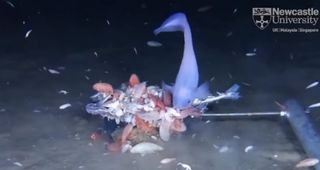This Squishy Deep-Sea Fish 'Melts' at the Ocean Surface (Video)
Scientists found three new species of fish in one of the deepest parts of the ocean, and these animals are so soft and squishy that they disintegrate if brought to the surface. Researchers captured remarkable footage that shows the fish in their alien home environment.
The new species, all snailfish, are adapted for life in ultradeep water, where temperatures are intensely cold and pressures far higher than any human could survive. Scientists filmed the fish in their natural environment as part of an international expedition to remotely explore the Atacama Trench, off the coast of Peru, and the discovery will be presented at the ongoing Challenger Conference at Newcastle University in the United Kingdom.
"As the footage clearly shows, there are lots of invertebrate prey down there, and the snailfish are the top predator. They seem to be quite active and look very well-fed," Thomas Linley, a researcher at Newcastle University who was involved in the expedition, said in a statement. [In Photos: Spooky Deep-Sea Creatures]
In the conditions present about 4.7 miles (7.5 kilometers) below the ocean surface, a squishy body is helpful in withstanding cold and extreme pressures, Linley said. So, the hardest objects in the snailfishes' bodies are their teeth and the bones in their inner ears, and the creatures have only minimal structural body parts.

"Without the extreme pressure and cold to support their bodies, they are extremely fragile and melt rapidly when brought to the surface," Linley said.
The researchers termed the three species the pink, purple and blue Atacama snailfish. The scientists did manage to remotely trap one specimen using one of the team's deep-sea probes after it followed some prey into its chamber. That specimen didn't survive the trip to the surface, but researchers have preserved its remains and, according the statement, it's in "very good condition" for study.
The researchers also filmed a rare "munnopsid" using their underwater probe. A sort of crustacean about the size of a human hand, a munnopsid swims upside down and somersaults to walk on its long legs.
Sign up for the Live Science daily newsletter now
Get the world’s most fascinating discoveries delivered straight to your inbox.
Originally published on Live Science.

